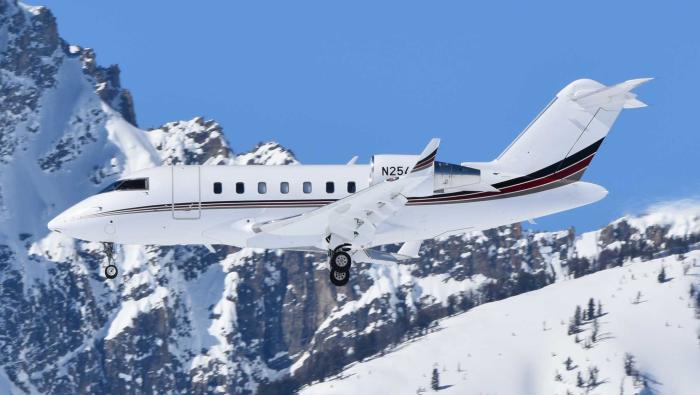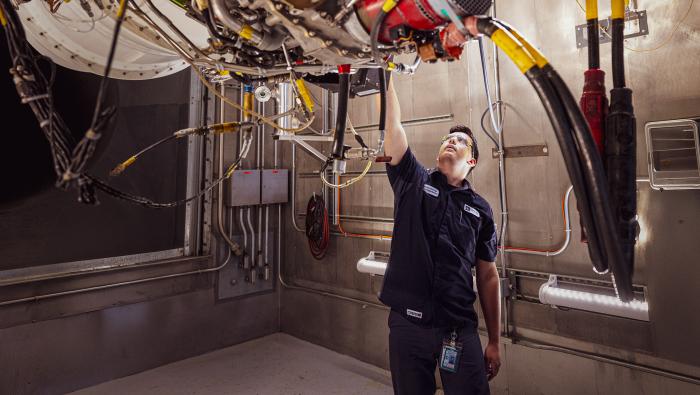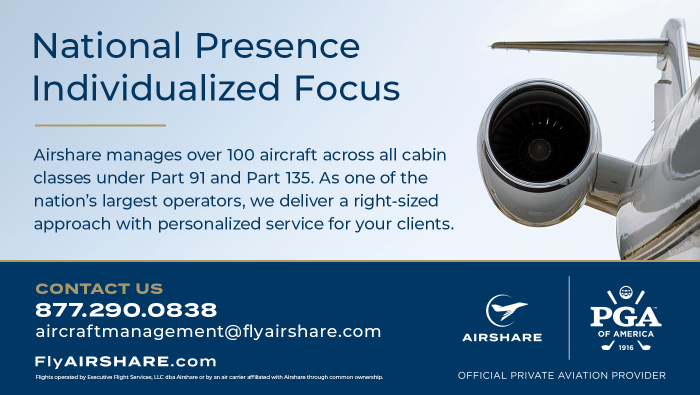|
Global business aircraft flight activity jumped by 7.2% in September as North America logged its largest monthly gain—outside of the initial Covid boom—in a decade, according to the latest Argus International TraqPak report. North American operations increased by 7.5% year over year (YOY), and Europe marked its fifth consecutive month on the positive side with a 2.5% increase. Outside of the Covid bump, the previous largest YOY gains in North America occurred in February 2016 and December 2019, both of which saw operations increase by 6.9%. In September, all operational categories trended positive in North America, led once again by fractional operations with a 13.2% increase. Part 135 activity was up 7.3% and Part 91 by 5.4%. All aircraft categories also posted gains, with light jets leading at 8.3%, followed by midsize jets, +8.2%; turboprops, +7%; and large-cabin jets, +5.6%. Accounting for both cabin size and operations, fractional large jet activity soared in September, up by 20.7%, and fractional small jets closely followed at a 19.3% gain. Only one segment dipped YOY—Part 135 large-cabin jet operations fell 0.4%. Meanwhile, in Europe, large-cabin jets led the YOY increases in September at 7.3%, followed by midsize jets at 3.5%. However, light-jet and turboprop activity dipped in the month by 1% and 0.6%, respectively. In the rest of the world, activity was up 11.4% YOY last month, led by light-jet operations, which leapt by 21.9%. |
|
|
Fatalities from turbine business airplane accidents worldwide increased nearly 24% in the first nine months versus the same period in 2024, according to preliminary data gathered by AIN. Twenty-five accidents involving business jets and turboprops accounted for 99 lives lost so far this year, up from 23 accidents resulting in 80 deaths through the third quarter of last year. Notably, U.S.-registered business jets was the only segment among all turbine-powered business airplanes to record fewer accident fatalities year over year in the first nine months. Further, there were no fatal accidents of U.S.-registered business jets in the third quarter. In the first three quarters of last year, 11 people were killed in four accidents of U.S.-registered business jets (one under Part 135) versus eight fatalities from three accidents (all under Part 91) this year. Meanwhile, six accidents of non-U.S.-registered business jets claimed 21 lives in the first nine months, compared with just two accidents and four fatalities in the same period a year ago. In the first nine months of this year, 23 people were killed in seven accidents involving U.S.-registered business turboprops—including one under Part 135 and one under public/government operations—versus 15 fatalities in six accidents (all under Part 91) last year. Meanwhile, 47 people died in nine accidents involving non-U.S.-registered turboprops this year versus 45 fatalities from 11 accidents last year. |
|
|
EBAA and GAMA are jointly opposing new European Commission plans to start taxing jet-A used by aircraft with fewer than 19 seats for both commercial and non-commercial flights. The new levy is part of a proposal for the wider Energy Taxation Directive (ETD), which was drawn up last month by the European Union. EBAA said the tax would amount to €0.40 ($0.46) per liter of fuel, which equates to around $1.74 per U.S. gallon. The group claimed this would effectively double the price of fuel for many operators. “To make matters even more paradoxical, sustainable aviation fuel used by business aviation would be taxed at a rate of €0.18 per liter, running counter to the EU objective of making SAF more affordable,” said the EBAA statement. “Meanwhile the rest of the aviation sector [i.e. operators of larger aircraft] would benefit from a 10-year exemption, with a review scheduled only afterwards. This marks a clear and unjustified discrimination against business aviation.” The business aviation industry groups have warned leaders of EU member states that the fuel tax will have negative consequences for the sector and, by extension, on Europe’s economy and transportation network. The ETD proposal is expected to be voted on during a meeting of the European Union’s Economic and Financial Affairs Council on November 13. |
|
|
The FAA has updated the helicopter route chart for the Washington, D.C. area as part of the regular 52-day update cycle and incorporated permanent changes after the January 29 midair collision between a PSA Airlines Bombardier CRJ700 and U.S. Army Black Hawk helicopter. Helicopter Route 4, which the Black Hawk was following, no longer exists, and Route 1 and other routes have been modified, both near Ronald Reagan Washington National Airport (KDCA), Washington Dulles International Airport (KIAD), and Baltimore/Washington International Thurgood Marshall Airport (KBWI). According to the FAA, Route 1 and 5 are to be used only by priority aircraft such as medical and law enforcement operations “unless specifically authorized by air traffic control.” This change was enacted immediately after the accident. Other changes include reducing the boundaries of Zones 1, 2, and 5 and adding notes to the chart “to improve clarity around altitude and operational instructions.” With the elimination of Route 4, there is now no VFR helicopter route south past KDCA. Since the midair collision, the FAA has changed procedures “to eliminate helicopter and fixed-wing mixed traffic near the airport “ and closed Route 4 permanently between Hains Point and the Wilson Bridge. It also has “revised agreements with the military to require ADS-B Out broadcasting “ and “eliminated the use of visual separation within 5 miles of the airport .” |
|
|
Sponsor Content: Duncan Aviation Duncan Aviation is significantly enhancing its turbine engine capabilities with the construction of a new 36,000-square-foot Pratt & Whitney Canada Designated Overhaul Facility (DOF) for PW300 and PW500 turbofan engines that is nearing completion |
|
|
Corporate Air, an FBO and aircraft charter/management provider at Pittsburgh-area Allegheny County Airport (KAGC), has declared bankruptcy. While it undergoes Chapter 11 restructuring, Vantage Aviation will act as plan sponsor and provide financial support to keep Corporate Air in operation with no impact to the employees jobs, salary, or benefits. Customers and vendors can expect no further interruptions to the business, according to a statement from both companies. The Corporate Air facility includes more than 110,000 sq ft of hangars that can accommodate the latest ultra-long-range business jets, as well as 20,000 sq ft of terminal and office space. Vantage, founded by industry veteran Ryan Maxfield and backed by Jadian Capital, made its debut as an FBO brand last year. It has already acquired five facilities, with a sixth under construction. Upon approval by the U.S. Bankruptcy Court for the Western District of Pennsylvania, Vantage expects to become Corporate Air’s new equity holder. The Allegheny County Airport Authority unanimously approved the conditional assignment of the 20-plus-year remainder of the ground lease for the Corporate Air facility, conditional upon Vantage being named the equity holder of the company. The bankruptcy proceedings could last for up to 90 days, with the next hearing scheduled for October 22. |
|
|
The FAA’s Part 108 proposed rule for normalizing unmanned aircraft systems (UAS) beyond visual line of sight operations (BVLOS) “introduces significant changes to how aircraft share the low-altitude airspace where vertical flight operations routinely take place,” according to Vertical Aviation International (VAI). While VAI supports safe integration of drones into the National Airspace System (NAS) and “recognizes the importance of advancing BVLOS operations for UAS,” it also said the “proposed rule relies on inaccurate assumptions about the low-altitude environment, proposes significant changes to long-standing right-of-way rules, and risks creating unnecessary hazards in the airspace.” In comments to the proposed rule, VAI said, “Right-of-way rules must continue to protect the least maneuverable aircraft; manned aircraft should retain precedence over UAS within the right-of-way hierarchy.” It added, “Detect-and-avoid systems must include redundant, overlapping systems (including onboard broadcast receivers for UAS systems and visual and/or acoustic systems) as part of a phased approach to ensure reliable avoidance maneuvers upon the effective date of Part 108.” Heidi Williams, NBAA v-p of air traffic services and infrastructure, said the association and its members have several concerns, “including the need for electronic conspicuity, or sharing of position, for all aircraft in the NAS.” Electronic conspicuity uses GPS-dependent signals to provide position information about aircraft or UAS. |
|
|
Nimbl has introduced an emergency response plan (ERP) guide designed to help business aviation operators strengthen their preparedness for possible crises. The company reported an 85% increase in operators adding ERPs from 2023 to 2024. According to Nimbl, operators are increasingly recognizing the importance of formal response planning, including smaller operations that may have fewer resources. The company's guide consolidates years of ERP expertise into a single resource and outlines the core elements required for an effective plan. It also provides recommendations for testing against a range of scenarios, including aircraft accidents, natural disasters, and security incidents. Nimbl noted that the need for thorough emergency response planning has grown exponentially in an evolving aviation environment. “Compiling an ERP guide that covers all aspects of operational safety is just another way we help to ensure our customers are as prepared as possible for whatever may happen,” said Nimbl director of product development Kevin Honan. Providing free safety resources is consistent with Nimbl’s approach to supporting continuous operator improvement, according to the company. Nimbl noted that the ERP guide is intended to help mitigate risks during emergencies by giving operators structure for emergency response, based on experience. Headquartered in the Washington, D.C. area, Nimbl (née AviationManuals) supports more than 4,000 operators worldwide with safety management, procedures manuals, and compliance support. |
|
|
AIN is boosting its coverage of the commercial aviation sector by featuring a selection of special reports from Leeham News & Analysis (LNA). Increasingly, the two outlets are collaborating on content since AIN Media Group acquired the latter respected independent platform in June. Next month, AIN’s daily editions at the Dubai Airshow will be packed with breaking news from this key event for the Middle East. These issues will also feature exclusive special reports produced by the Leeham team led by industry experts Scott Hamilton and Bjorn Fehrm. The opening day’s issue on November 17 will include Leeham’s independent analysis of 13 aircraft designs in contention to make it to market as next-generation airliners. In our second edition on November 18, the Leeham team will provide expert commentary on how the aerospace industry will produce the next generation of airliners. Fehrm, a well-versed aerospace engineer, has spoken to fellow experts about the changes in technology and process that are required. All three issues will feature exclusive news updates from the Leeham during the show. The AIN team is already working on feature stories for our editions at the Dubai Air Show. If your company is exhibiting, please contact show daily editor Hanneke Weitering to share details of news you plan to announce and other topics of interest to readers. |
|
|
Teterboro to Cleveland and Back on a Flexjet Gulfstream G450 AIN sister-publication Business Jet Traveler recently flew from Teterboro, New Jersey, to Flexjet’s headquarters in Cleveland on one of the fractional provider’s Gulfsteam G450s to witness the unveiling of its two new G700s. |
|
|
|
|
|
|
AINalerts News Tips/Feedback: News tips may be sent anonymously, but feedback must include name and contact info (we will withhold name on request). We reserve the right to edit correspondence for length, clarity, and grammar. Send feedback or news tips to AINalerts editor Chad Trautvetter. |
|
AINalerts is a publication of AIN Media Group, 214 Franklin Avenue, Midland Park, New Jersey. Copyright 2025. All rights reserved. Reproduction in whole or in part without permission is strictly prohibited. |

















